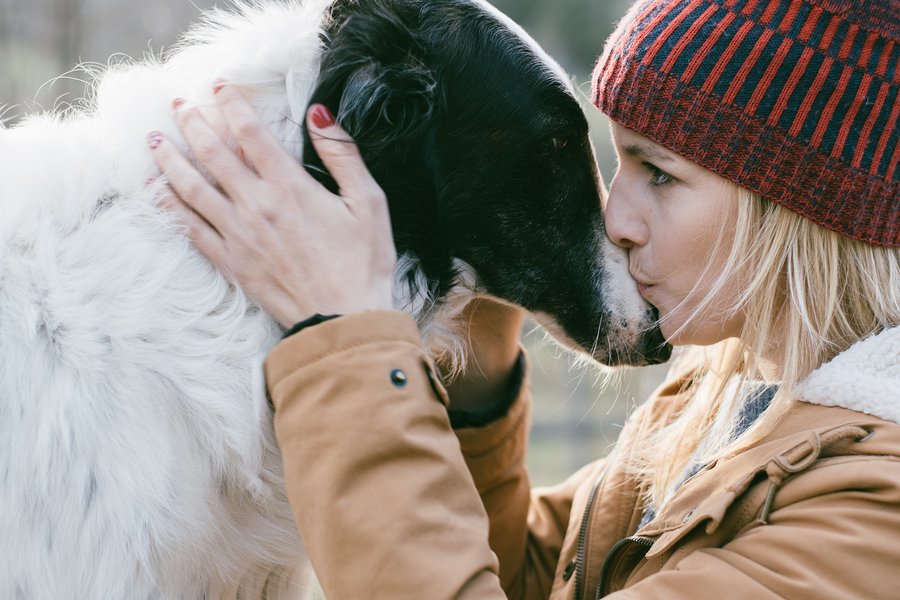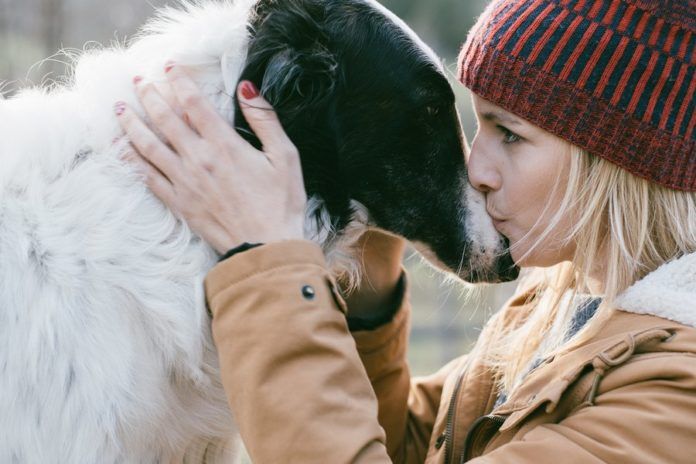
When it comes to the sense of smell, dogs leave us in the dust. They have nearly 20 times more primary smell receptor cells in their noses than people do. They can detect scents at concentrations at least 100 times less than humans can. In some instances, they can detect scents at concentrations a million times less than we can. And if you ironed out the aroma-detecting membranes covering the scrolled-up, coral like bones in a dog’s nose, their surface would be the size of a pocket handkerchief, while ours would be roughly the size of a thumbnail.
It’s no wonder research has suggested that dogs can smell sickness on us — serious sickness. Apparently, they can pick up the odor of compounds generated by malignant tumors. That’s right. They seem to be able to literally smell cancer.
Dogs can detect diabetes, too. And they’ve been put to use as home health aides because of it. Dogs who live with people with type 1 diabetes — the kind where the body is unable to produce any insulin at all — have been trained to start barking when their owners begin to experience hypoglycemia, a situation in which blood sugar falls too low. (That can happen if, say, medication to control the disease and help remove sugar from the bloodstream overshoots its mark.) It’s critical work. If hypoglycemia proceeds unchecked, it can lead to a diabetic coma. The barking reminds the person to immediately eat or drink something with sugar — a glass of juice, perhaps.
Here’s the thing, though. Despite our olfactory deficiencies in comparison to dogs’, we can smell some cancers and severe diabetes — and several other diseases — on them! And if we do, we can get them the medical help they need sooner rather than later, perhaps warding off the progression of disease and increasingly expensive treatments to manage something that’s farther along. Here’s the rundown.
Diabetes. When a dog (or a person, for that matter), has diabetes, he is not able to break down blood sugar in an efficient way for the body to use as fuel. Instead, he starts breaking down fat. That can result in the production of compounds called ketone bodies, which accumulate in the blood. A dog works to eliminate ketones, which are toxic, through respiration. But the ketones, in turn, give his breath a sweet odor, which people are able to smell.
Cancer. We can’t smell all kinds of cancer on dogs. But we can detect the odor of malignant tumors in their mouths — oral cancers. The scent is, well, sickening, to the point that it can be hard to take. That’s because it comes from necrosis — cell death. Oral cancers can also be recognized by a change in a dog’s breath.
Don’t assume that if there’s a change in the scent of your dog’s breath, he automatically has cancer. It can signify other things as well, like dental disease. But a change or a particularly awful stench should prompt a visit to the veterinarian, especially since you may not see an oral tumor. “Many times they’re in the back of the mouth, where they’re not necessarily noticeable,” says Tufts veterinary surgeon John Berg, DVM. And unfortunately, he says, they can be among the most difficult cancers to treat. They often grow fast, into surrounding bone and tissue, and they also spread quickly to other parts of the body, which is why you want to catch them as early as you can.
Kidney disease. In a dog (or person) with properly functioning kidneys, breakdown products of protein make their way into the urine and then out of the body. In a dog (or person) with kidney disease, those breakdown products (which are toxic) build up in the blood because the kidneys fail to filter them from the bloodstream so they can be eliminated. One of those breakdown compounds is blood urea nitrogen, and a dog with high levels of it may have a scent on her breath that smells like ammonia. It makes sense. Ammonia is a breakdown product of urea.
Urinary tract infection. A dog with a urinary tract infection may pass urine that has a very foul odor. Some say it smells quite sour, while others have equated it with the scent of rotting fish. However you perceive the odor, it will be much different from what you’re used to smelling — or at least much stronger. And it’s a sign that you should take your dog to a veterinarian for a workup. If a urinary tract infection is diagnosed, an antibiotic will be prescribed to make the harmful bacteria causing the problem die out. The displeasing scent of your dog’s urine will die away, too.
A few notes here. The first is that the absence of an especially pungent odor emanating from your dog’s urine doesn’t mean a urinary tract infection doesn’t exist; other telltale signs of a UTI include more frequent urination and straining to urinate, and they don’t have to be accompanied by the extra-strong scent.
Conversely, the presence of a very strong odor produced by the urine can mean something other than an infection. Consider that before coming into heat, a female dog’s urine may become stronger-smelling as a way of alerting male dogs that she is ready to impregnate. Incontinence can lead to an unpleasant odor as well. It’s not the urine itself in that scenario but the fact that if the dog dribbles urine onto her coat while sleeping, it will dry there — and the scent will remain.
Yeast infection. Is an odor that smells like fermentation coming from your dog’s ear? Is it especially unpleasant? Is it accompanied by a brown, waxy discharge? If so, your dog may have a yeast infection, which could even have a soup-like appearance. (Don’t try to remove the discharge with a Q-tip — that is a job for your veterinarian.)
Like yeast infections, bacterial infections in a dog’s ear can have a strange smell, too — a pungent one. It could even be sweet if the bacteria are of the pseudomonas variety, which is relatively common. In instances of bacterial infection, the discharge tends to be a yellowish to green pus rather than a brown waxy discharge. The dog will need both topical medication and medication taken by mouth in order to clear up the problem, and some severe ear infections require surgery.
Parvovirus. Diarrhea smells bad to begin with, so how can its scent provide a clue to illness? If it’s particularly foul-smelling, it could be a sign of parvovirus, which means there’s dead tissue in the runny stools. And the odor of dead tissue is especially nasty.
How does it make its way into a dog’s waste? The virus actually kills intestinal cells. Those dead cells then slough off and make their way into the dog’s excrement.
Along with the odor (and blood in the diarrhea, too), parvovirus often brings lethargy and vomiting and is life-threatening if left untreated. Almost all pet dogs get regular vaccinations against this condition, but if for some reason your pet has missed her booster shot (or your puppy has missed one of her initial vaccinations) and she is exhibiting some of the classic signs of the illness, get her to the doctor right away. Young dogs in particular are more likely to develop parvovirus.
Periodontal disease. Dogs often have hard-to-take breath. That’s okay (at least for the dog). But if the odor is particularly strong and unpleasant, and especially if it’s combined with loose teeth and pus, the dog probably has advanced periodontal disease, the medical term for gum disease. It means the gums around her teeth have deteriorated significantly, and perhaps the bone anchoring her teeth has deteriorated, too. And once the gum-and-bone scaffolding fall apart, the teeth are more apt to loosen and even fall out. If the problem goes far enough, even the jaw itself can weaken. That results in small blood vessels beneath the bone becoming damaged and bleeding — a set-up for letting bacteria make their way into the bloodstream.
As we said in the March 2018 issue (“The 6 Misconceptions That Prevent People from Taking the Best Care of Their Dogs’ Teeth“), the simplest way to prevent all that is to brush your dog’s teeth once a day, every day. You should also take your pet for regular dental cleanings once the vet starts recommending them because while the dog is under anesthesia, the doctor can get where a toothbrush can’t reach — under the gum line.
Skin fold pyoderma. A fold in a dog’s skin allows two surfaces of skin to touch each other, or at least be near each other, and provide the warm and humid environment that bacteria need to duplicate and thrive. The result is a pyoderma, a bacterial infection of the skin. It’s not that the bacteria are foreign to the skin; they live there. But when they overgrow in the moist environment, discharge occurs, along with what is often a foul or musty odor. Wrinkly breeds like shar peis are most susceptible, but any dog could end up developing skin fold pyoderma in the folds of the lip, the groin, or the “arm pits.” Female dogs can end up with it between the mammary glands if they have had multiple litters. A female dog might also develop the condition above her vulva if she has a congenital condition known as a recessed vulva. That means there’s a skin fold right above the external part of the vagina.
Treatment includes using a medicated skin cleanser on the affected area, antibiotics, and, if the condition is severe enough, surgery. You need to keep susceptible areas clean and dry to prevent recurrences. n





